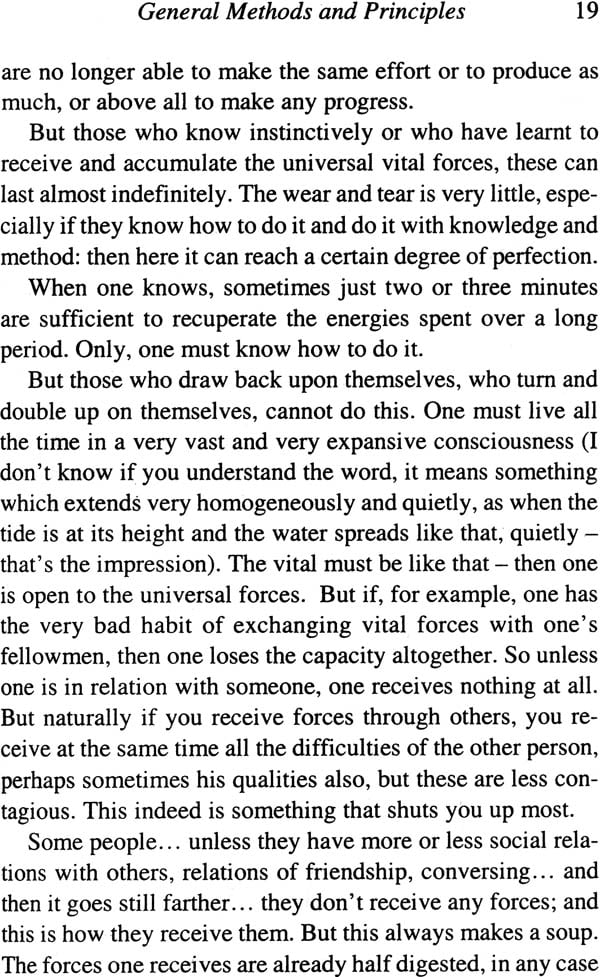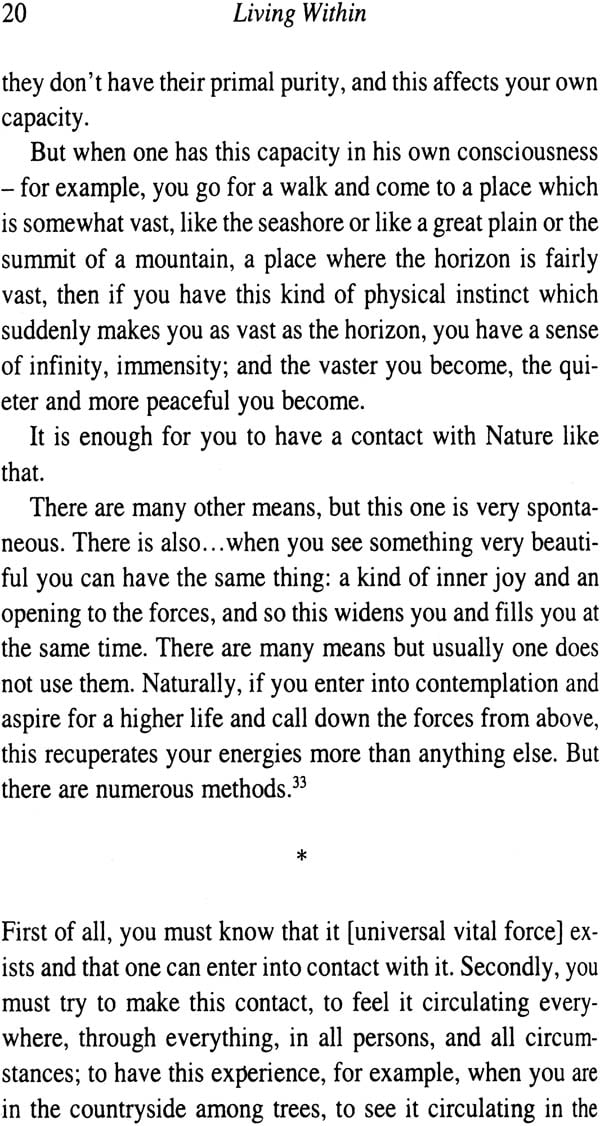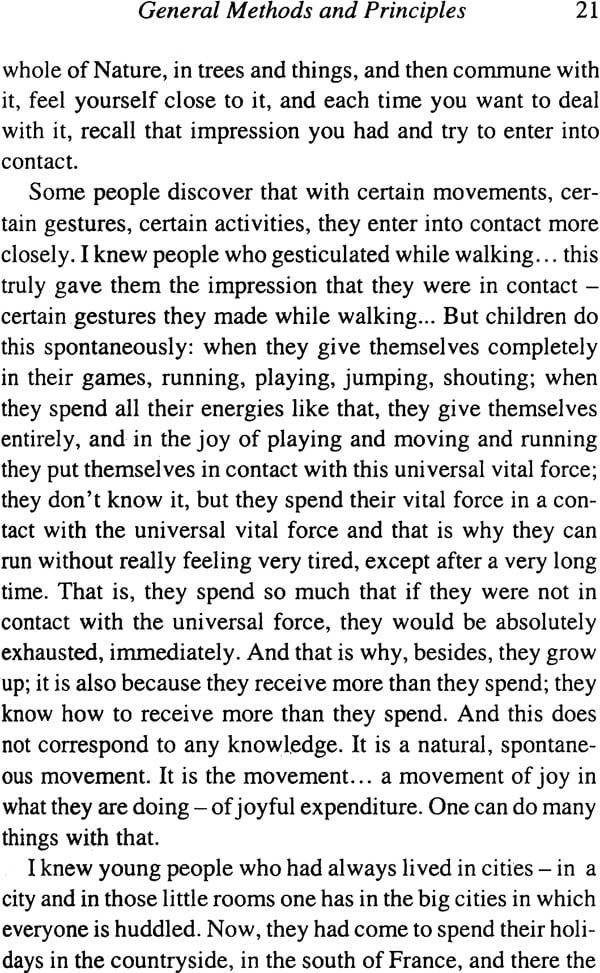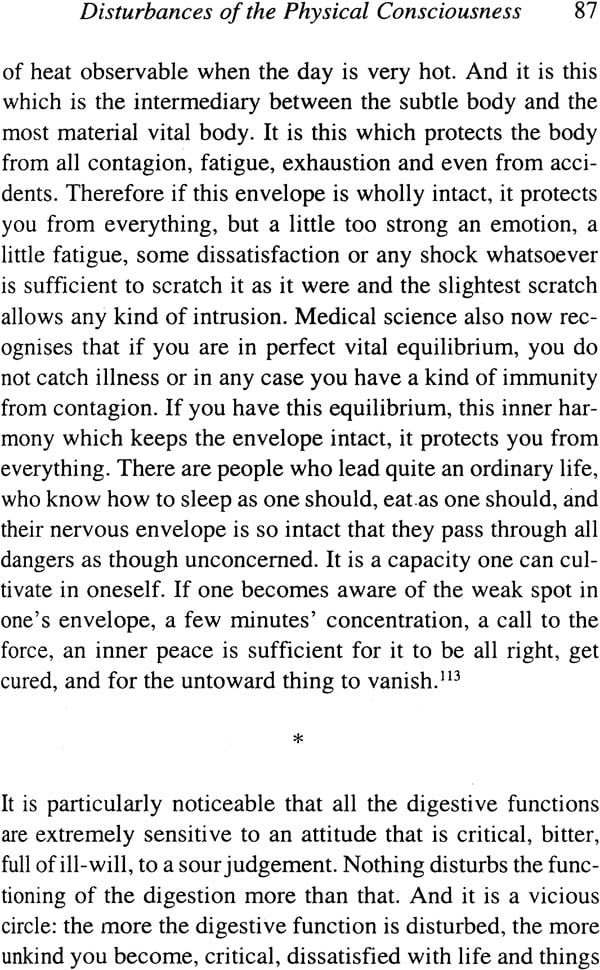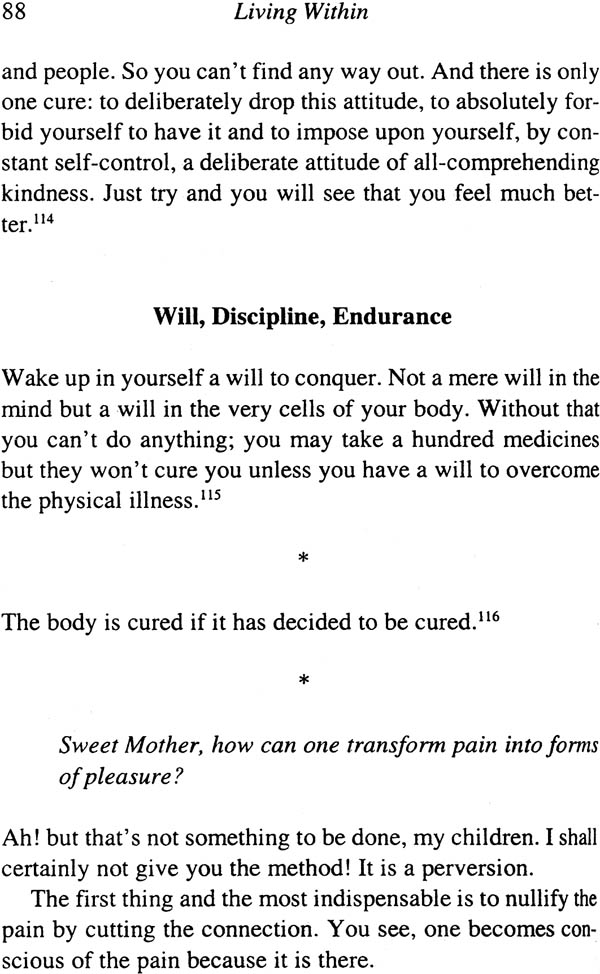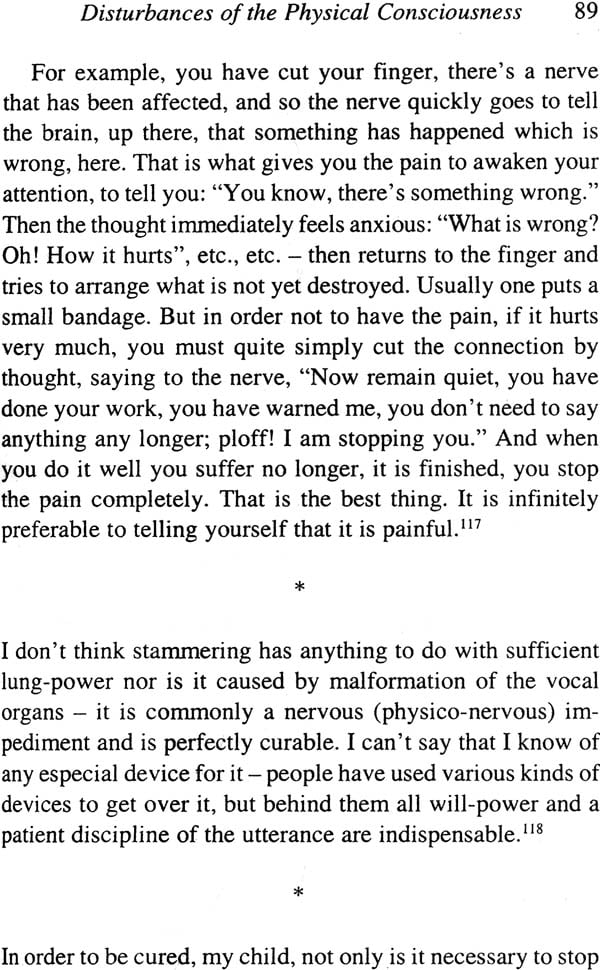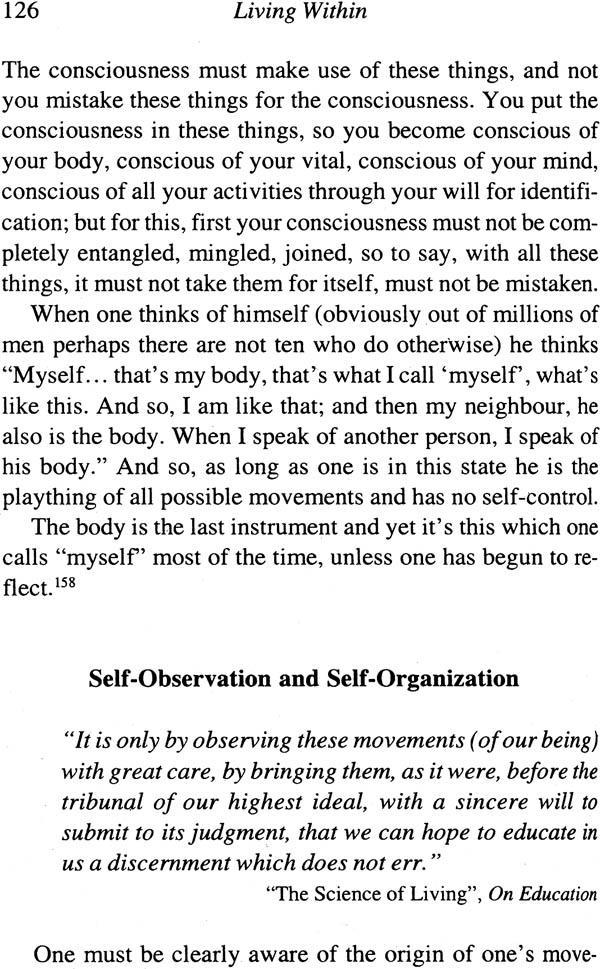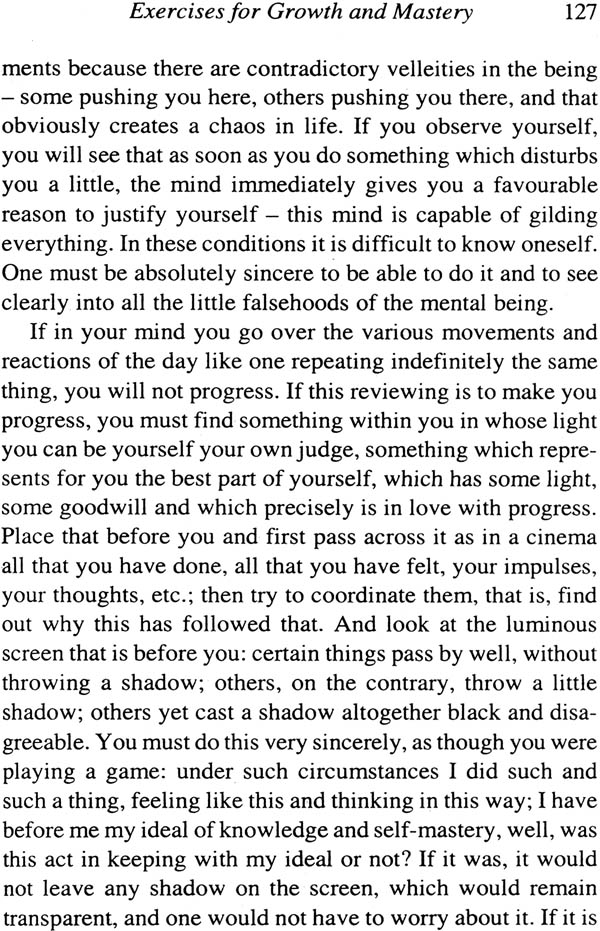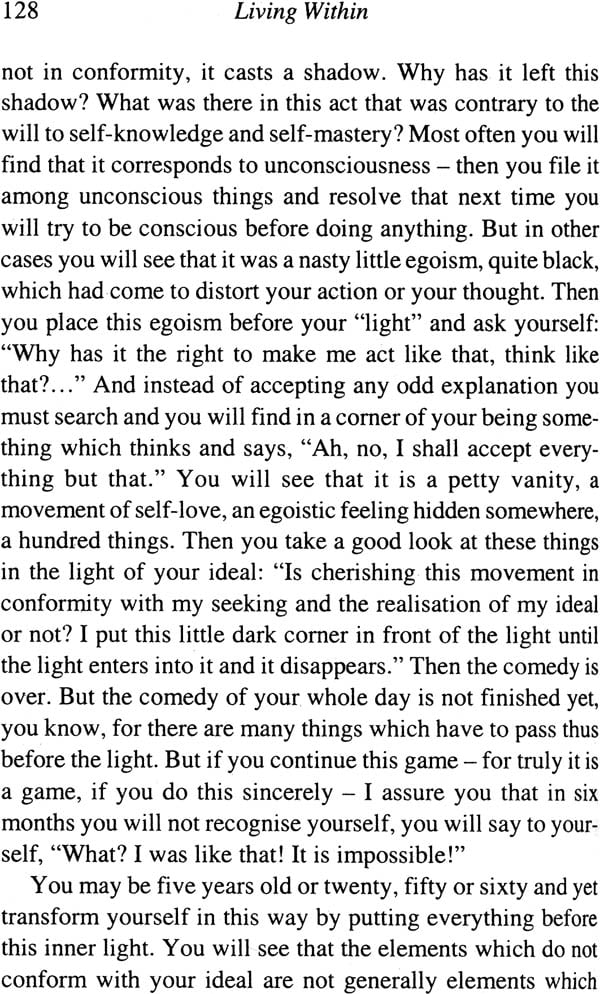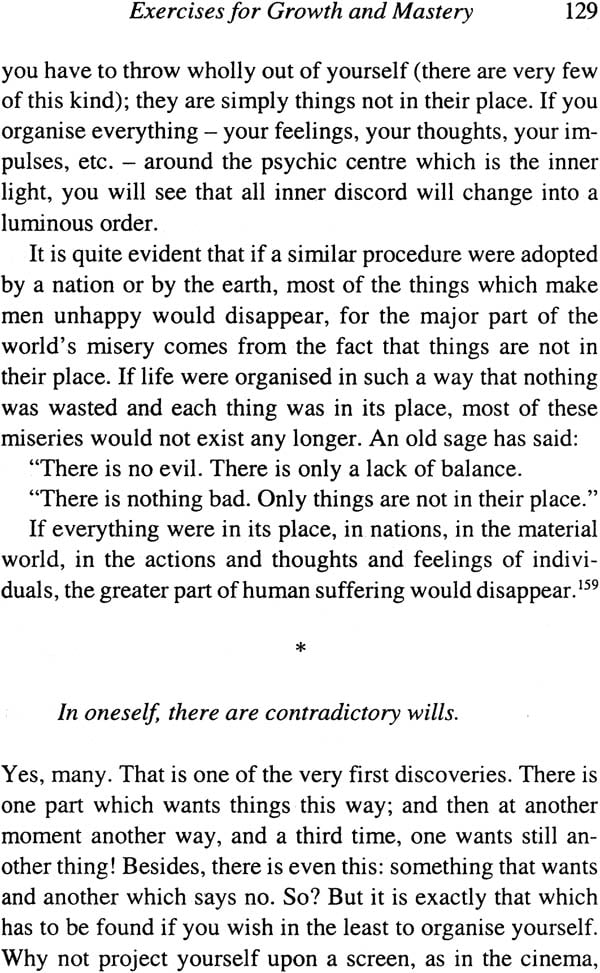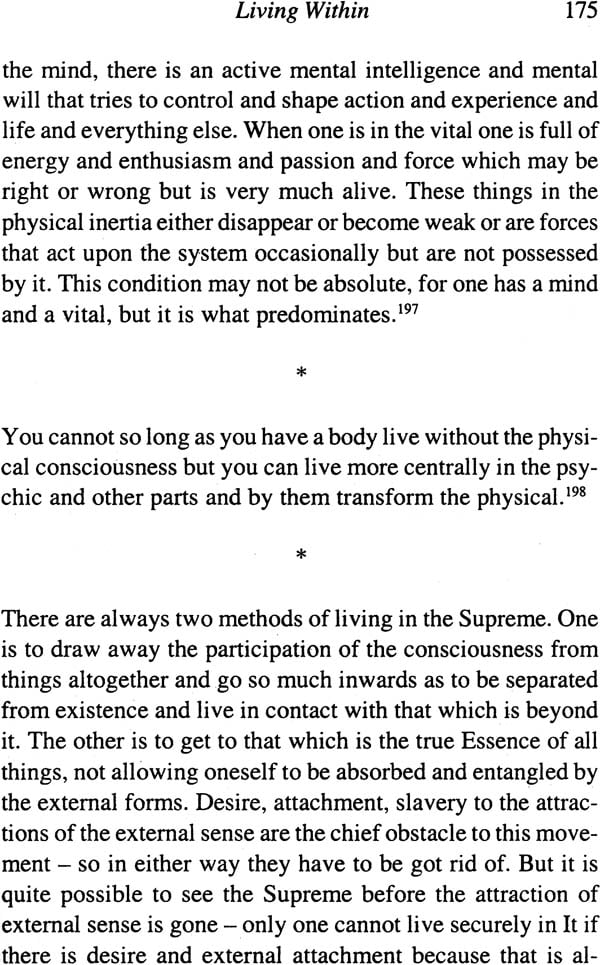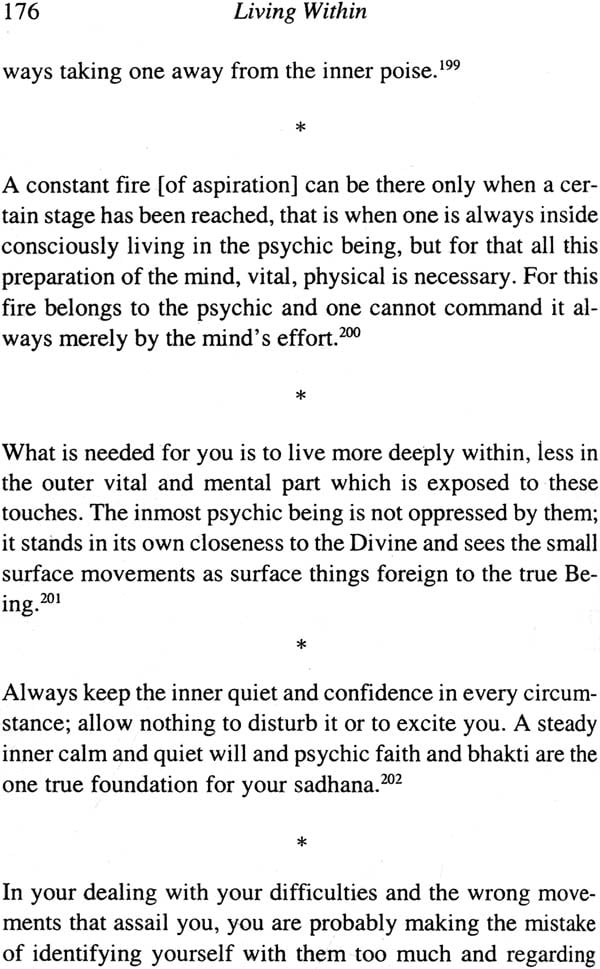
Living Within (The Yoga Approach to Psychological Health and Growth)
Book Specification
| Item Code: | NAL686 |
| Author: | A. S. Dalal |
| Publisher: | Sri Aurobindo Ashram, Pondicherry |
| Language: | English |
| Edition: | 2016 |
| ISBN: | 9788170589921 |
| Pages: | 240 |
| Cover: | Paperback |
| Other Details | 7.0 inch X 5.0 inch |
| Weight | 230 gm |
Book Description
Mental health is generally understood as an absence of marked psychological disturbances such as fear. anxiety, depression, anger, jealousy, etc. However it is increasingly felt that it is not the mere absence of these elements, but the presence of certain positive characteristics such as peace, inner security and confidence that should denote mental health. Moreover, the constant chatter and distractibility of the mind, the perpetual hankering for different objects of desire, and the recurrent pull of inertia are also states of psychological disturbance which mar inner well-being.
Yoga is a psychological approach which aims at a radical change of consciousness. This book presents some of the principles and methods of Sri Aurobindo's integral yoga for overcoming psychological disturbances and for attaining positive mental health.
Our psychological state is normally characterized by continual disturbances of varying degrees of severity. Some of the common disturbances are fear, anxiety, depression, insecurity, restlessness, anger, jealousy, suspicion, etc. Up to a certain degree, such disturbances are considered "normal". When the disturbances experienced by an individual exceed what is regarded as normal, the person is said to be suffering from a lack of "mental health". When disturbances reach extreme proportions and significantly disable an individual, the person is deemed to be suffering from mental illness. Thus mental health is generally understood as absence of marked psychological disturbances.
An increasing number of people, however, find such a view of mental health unsatisfactory for two reasons. First, it is felt that mental health should consist in certain positive characteristics which impart a positive sense of psychological well-being, such as peace, inner security, confidence, a sense of mastery, etc.; the mere absence of significant disturbances does not constitute mental health. Secondly, people are beginning to realize that it is not only the more acute disturbances such as anxiety, depression, agitation, etc. that impair mental health; even such things as the constant chatter and distractibility of the mind, the perpetual hankering for different objects of desire, the recurrent pull of inertia, etc. - which few look upon as psychological disturbances - are felt by more and more people as states that mar inner well-being and therefore denote a lack of mental health.
To such people, yoga may have something valuable to offer. For yoga is a psychological approach which aims at a radical change of consciousness so as to lead to a state of immutable and unconditioned peace, freedom and joy. The perfect yogic state has been described as not only free from all disturbances, but also immune to them by virtue of its positive characteristics.
Every system of psychological healing is based on a certain conception of the nature of the human being - what a human being is made up of, what is normal about human nature, and what constitutes an abnormality or a disturbance. Therefore, in order to apply any methods of psychological healing, it is necessary to understand the underlying conceptions about human nature and about the psychological disturbances on which the methods are based. This introductory chapter aims at explaining the nature of the human being, of psychological disturbances and of mental health in the light of the Integral Yoga of Sri Aurobindo and the Mother. Without a good grasp of these explanations it would be difficult to follow much of what is contained in the rest of the book.
Our being is a complex amalgam of many different elements. We are vaguely conscious of only the more superficial ones. Apart from the body and its sensations, we are to some extent conscious of various psychological elements, such as thoughts, feelings, desires, impulses, etc., all of which are lumped together and generally referred to as the "mind". However, from the viewpoint of the Integral Yoga, our being is made up of various distinct parts. As Sri Aurobindo remarks:
"The 'Mind' in the ordinary use of the word covers indiscriminately the whole consciousness, for man is a mental being and mentalises everything ... "
"Each plane of our being - mental, vital, physical- has its own consciousness, separate though interconnected and interacting; but to our outer mind and sense, in our waking experience, they are all confused together."
The three parts of the being referred to above - mental, vital, physical - constitute the outer being, each part having its own distinct nature and characteristics. Below is a brief description of each of these three parts in Sri Aurobindo's words:
" ... in the language of this yoga the words 'mind' and 'mental' are used to connote specially the part of the nature which has to do with cognition and intelligence, with ideas, with mental or thought perceptions, the reactions of thought to things, with the truly mental movements and formations, mental vision and will, etc., that are part of ... intelligence. The vital has to be carefully distinguished from mind, even though it has a mind element transfused into it; the vital is the Life-nature made up of desires, sensations, feelings, passions, energies of action, will of desire, reactions of the desire-soul in man and of all that play of possessive and other related instincts, anger, fear, greed, lust, etc., that belong to this field of the nature. Mind and vital are mixed up on the surface of the consciousness, but they are quite separate forces in themselves and as soon as one gets behind the ordinary surface consciousness one sees them as separate, discovers their distinction and can with the aid of this knowledge analyse their surface mixtures.”
"The body ... has its own consciousness and acts from it, even without any mental will of our own or even against that will, and our surface mind knows very little about this body-consciousness, feels it only in an imperfect way, sees only its results and has the greatest difficulty in finding out their causes.”
"In many things, in matters of health and illness for instance, in all automatic functionings, the body acts on its own and is not a servant of the mind. If it is fatigued, it can offer a passive resistance to the mind's will. It can cloud the mind with tamas, inertia, dullness, fumes of the subconscient so that the mind cannot act. The arm lifts, no doubt, when it gets the suggestion, but at first the legs do not obey when they are asked to walk; they have to learn how to leave the crawling attitude and movement and take up the erect and ambulatory habit. When you first ask the hand to draw a straight line or to play music, it can't do it and won't do it. It has to be schooled, trained, taught, and afterwards it does automatically what is required of it. All this proves that there is a body-consciousness which can do things at the mind's order, but has to be awakened, trained, made a good and conscious instrument.”
(It should be noted that the body-consciousness is only part of the whole physical consciousness; the latter permeates also the vital and the mental.)
Since the various parts of the being are interconnected, they interact on one another, resulting in distinguishable subdivisions within each part of the being. Thus, besides the mind proper, there is a part of the mind which is interfused with the vital, called the vital mind. There is also a part of the mind which is interfused with the physical, called the physical mind. Similar subdivisions exist within the vital and the physical. Three of these various subdivisions are particularly relevant to the subject-matter of this compilation, and are described below. These three subdivisions are: the physical mind, the vital mind and the vital physical.
The physical mind is the aspect of the mind which partakes of the characteristics of the physical consciousness. Some of the chief characteristics of the physical, namely, inertia, the tendency to act mechanically like an automaton, repetitiveness, constriction and chaotic activity are reflected in the physical mind in the form of mental torpor, doubt, obscurity, confusion, mechanical reactions to things and habitual modes of thinking. The part of the physical mind which is closest to the physical is referred to as the mechanical mind; it acts like a machine that goes on turning round and round whatever thoughts occur in it.
The vital mind is influenced by vital forces and movements, and therefore cannot think freely and independently of such influences as the thinking mind can do. The function of the vital mind is not to think or reason, but to dream and imagine, whether it is about success or failure, enjoyment or suffering, good fortune or ill fortune.
The vital physical refers to the part of the physical that is intermixed with the vital. It is this part that is involved in the reactions of the nerves and the reflexive sensations and feelings. It is also the agent of pain.
From the viewpoint of Integral Yoga, each part of the outer being has certain inherent psychological disturbances. The following sections delineate the disturbances associated with each of the different parts mentioned above.
| Introduction | xi | |
| 1 | General Methods and Principles | |
| The One Way - Quiet, Calm, Peace | 1 | |
| Becoming More Conscious | 3 | |
| Observation Versus Analysis | 6 | |
| Using the Will | 7 | |
| Rest and Relaxation | 9 | |
| Sleep | 12 | |
| Recuperating One's Energies | 18 | |
| Detachment and Rejection | 23 | |
| Equality | 27 | |
| 2 | Disturbance of Mind | |
| Mental Noise | 30 | |
| Obsessive and Compulsive Thoughts | 32 | |
| Unruly and Perturbing Thoughts | 35 | |
| Anxiety | 44 | |
| 3 | Disturbance of the Vital | |
| Fear | 50 | |
| Boredom and Lack of Energy | 53 | |
| Depression | 56 | |
| Anger | 58 | |
| Haste and Agitation | 61 | |
| Feelings of Inferiority | 64 | |
| Sensitiveness | 66 | |
| Jealousy | 68 | |
| Transforming the Vital | 69 | |
| 4 | Disturbance of the Body and Physical Consciousness | |
| Rest, Quiet, Goodwill | 86 | |
| Will, Discipline, Endurance | 88 | |
| Preoccupation with Illness | 91 | |
| Faith and Suggestion | 94 | |
| Medicines | 99 | |
| Healing the Nerves | 101 | |
| 5 | Disturbances of the Subconscient | |
| How to Deal with the Subconscient | 108 | |
| Subconscient Habits | 110 | |
| Collective Subconscious Influences | 111 | |
| 6 | The Psychic Being and Psychological Health | |
| The Psychic - Source of Inner Well-Being | 119 | |
| 7 | Exercises for Growth and Mastery | |
| Stepping Back | 123 | |
| Becoming Aware of "Oneself" | 124 | |
| Self-Observation and Self-Organization | 126 | |
| Visualization for Discovering One's Being | 131 | |
| Awakening the Inner Consciousness | 134 | |
| Exercising Static Power | 138 | |
| Becoming Aware of the Shadow | 139 | |
| Mastery Through Attitude | 143 | |
| Identification | 144 | |
| Widening the Consciousness | 150 | |
| Dynamic Meditation | 155 | |
| Drawing upon Helpful Forces | 156 | |
| Self-Recollection - Remembering | 157 | |
| Using Life as a Mirror | 158 | |
| Establishing Peace in the Mind | 161 | |
| 8 | Living Within | 163 |
| Glossary | 181 | |
| References | 183 | |
| Index | 189 |

